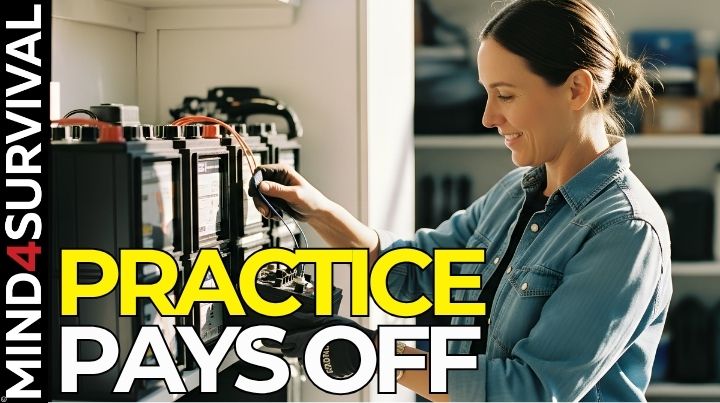Pressure-Test Your Plan: 8 Weekend Survival Drills

Podcast: Play in new window | Download
A couple of weeks ago, I asked the Mind4Survival Facebook group a simple question: “If you could pressure-test one part of your plan this weekend, what would it be?”
The answers came from several members of the Mind4Survival Facebook group—people just like you. They were all honest and thoughtful responses about the gaps they wanted to close. Four of their responses stood out, and they inspired a list of simple, effective tests you can run this weekend to strengthen your own plans.
TL;DR: Test your preparedness plan by running a simple drill this weekend to quickly identify and fix any gaps before an emergency.
Quick Look at What You’ll Learn
Audra Turns a Forced Outage into a Test
Let’s start with Audra, who found herself with an unexpected opportunity.
She wrote:
“Well, I get to practice my power loss preps starting Monday. A lineman stopped by telling me they were replacing the line and that I should prepare for an 8 am to 2 pm outage. The high will be 40, with a low in the 20s. I won’t be pulling out the big generator unless I have to. Going to run the fireplace blower from our battery bank and see how long it runs on a full charge. I will also be breaking out the old standby kerosene heater for our bathroom, so my pipes don’t freeze. Might run an extension cord to the battery bank for the Starlink so my kiddo does not drive me insane. I will also be able to bust into my water jugs, and it will give me the chance to refill with fresh water.”
Audra is turning a forced power outage into a full test run. She’s checking her battery bank’s capacity, deploying a backup heat source, keeping her family’s communications online, and rotating her water supply. This is a perfect example of turning an inconvenience into a drill that builds real confidence and capability. What’s a positive side of preparedness? Seizing opportunity, and that’s what she’s doing.
Rebecca Nails Winter Prep in Six Words
Next, Rebecca nailed practical winter prepping in just six words. She lives in the mountains of Washington state, where she’s largely snowed in for much of the winter.
Rebecca wrote: “Low 20s, so I guess I’m testing for drafts.”
It’s simple and excellent. Drafts steal heat, wasting energy and resources. A quick check now means a warmer, more efficient home when the temperatures really drop. It’s a small action that pays off big, especially with the potential of a heavy winter.
Eva Camps to Find the Holes
Then there’s Eva, who already uses camping to find holes in her gear and plans.
She said: “We regularly test parts of our plans. Camping provides an opportunity to test products in more austere conditions. Overall, we are in good shape, but events like power outages remind us that long extension cords are always in demand. We should purchase additional ones, as things are not always where they need to be on a moment’s notice.”
Eva’s point about extension cords is something many of us discover during an outage. You might have one, but is it stored with your lights-out kit? Having dedicated items in your emergency supplies is a simple fix.
Eva also brought up two bigger threats: bugging out for wildfires and bugging in for nuclear attacks. She’s not satisfied with her 90-second “getaway” plan, especially since some critical items can’t live in a bug-out bag full-time. She also mentioned having materials to board up windows for a nuclear scenario. However, she isn’t going to test it by screwing them into the house and damaging her home.
This brings up a more complex area of preparedness: hardening your home against extreme threats. For nuclear fallout, the primary goal is to create a barrier between you and the radioactive particles outside. This involves more than just boarding up windows.
You would need to seal all air entry points. This includes vents for your furnace and water heater, bathroom fans, and even the small gaps around pipes. Use plastic sheeting and duct tape to create an airtight seal. You’d also want to shut off any systems that draw in outside air. The key is to stop the fallout from entering your shelter space. While it’s an extreme scenario, thinking through the steps helps you identify which materials you might need on hand.
To some, this may seem paranoid. However, I see it as a matter of having a game plan for a high-impact, low-probability event.
Stuart Focuses on Community Security
Finally, Stuart went straight to the pointy end of the prepping stick.
He wrote: “About the only thing I haven’t ‘pressure tested’ is armed patrolling of our neighborhood with certain trusted neighbors… and verifying firing lanes from various locations.”
Stuart is thinking about community security. While walking around your neighborhood armed with your boom stick might invite a run-in with the law, you have other options. If you ever need to walk an armed patrol for real, you’ll be on top of it—keep your weapon at the ready and your head in the game.
Even if you don’t have a group to walk the neighborhood with, walk it on your own. Create people in your mind and imagine how you would address things with 2, 3, and more people.
Walk around at different times of day. Identify choke points, blind spots, and likely avenues of approach for trouble. Think like an adversary: what would they do to cause the most disruption? That should help you spot vulnerabilities so you can work on solutions now.
Eight Practical Tests You Can Run This Weekend
These four responses inspired eight practical tests you can run this weekend. Pick one. Do it imperfectly. The goal is to learn.
- The 4-Hour Blackout. Kill the main breaker to your house for four hours. See what gear you grab first and what systems fail. This will reveal your gaps faster than any thought exercise.
- The Draft Hunt. With winter here, hunt for drafts around windows and doors. Use your hand, a lighter, or an infrared thermometer. Maybe you have a thermal optic. Do what you can to seal the leaks to save heat and money.
- Backyard Camp-Out. Test your gear Eva-style. No outlets, no taps. It’s the closest you can get to a real-world SHTF test without leaving home.
- The 90-Second Bug-Out. Time yourself grabbing your bag and other essential items for a rapid evacuation. Practice turns what would be a frantic scramble into a smooth, low-stress event.
- The Window Seal Walk-Through. You don’t have to actually board them up, but walk through the process of sealing your windows. Do you have the materials? Do you know the steps? This is a valuable capability for storms, civil unrest, or fallout.
- The Neighborhood Assessment. Walk your neighborhood with a critical eye. Note sightlines, cover, and vulnerable areas. Understand the terrain, houses, and streets you might have to defend.
- Rotate Your Resources. Like Audra, crack open a water jug and use it. Then, refill it with fresh water. Do the same for food, batteries, and medications. Rotation keeps your supplies ready.
- The Battery Bank Rundown. Know your limits. Plug in a light, a fan, or a device and time how long your battery bank lasts. Knowledge is power—in this case, literally.
The Bottom Line
The bottom line is that our plans are never truly finished. Audra, Rebecca, Eva, and Stuart are all doing a great job with their preparedness, yet they continue to find ways to fix weak points and reinforce their capabilities.
What’s that one area you’ve been putting off? Test it this weekend. You’ll know more, and you’ll be better off for it. You’re just one test away from being better prepared.
Additional Resources
Read the full article here









